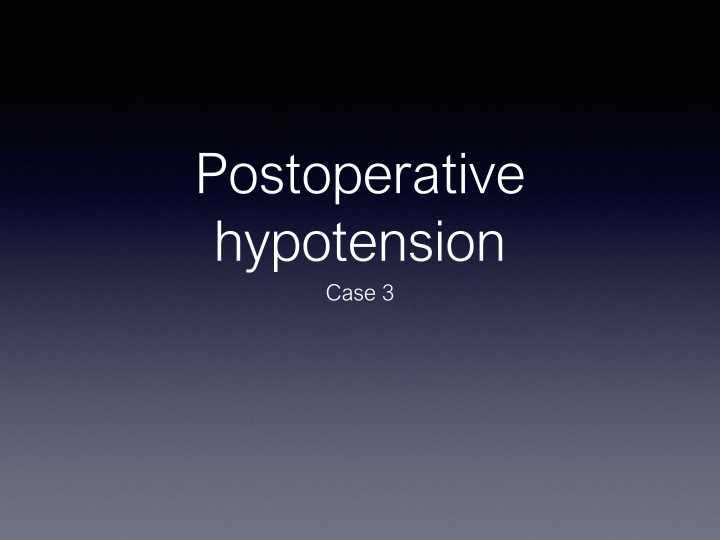
Postoperative Hypotension and Management Strategies
Learn about postoperative hypotension in a 66-year-old patient following a vaginal hysterectomy, differential diagnoses, clinical indicators of hypovolemia, monitoring, and effective management strategies. Explore potential causes such as blood loss, anaphylaxis, and myocardial depression, along with the importance of timely intervention in such cases.
Download Presentation

Please find below an Image/Link to download the presentation.
The content on the website is provided AS IS for your information and personal use only. It may not be sold, licensed, or shared on other websites without obtaining consent from the author. If you encounter any issues during the download, it is possible that the publisher has removed the file from their server.
You are allowed to download the files provided on this website for personal or commercial use, subject to the condition that they are used lawfully. All files are the property of their respective owners.
The content on the website is provided AS IS for your information and personal use only. It may not be sold, licensed, or shared on other websites without obtaining consent from the author.
E N D
Presentation Transcript
Postoperative hypotension Case 3
66-year-old mother of two young children, attended as an inpatient for an elective vaginal hysterectomy and repair of prolapsed under spinal anesthesia . She had no relevant past history and her preoperative assessment was unremarkable. During surgery, blood loss was greater than usual at 800 ml but no other problems were noted. In the recovery room she was well but noted to be pale and agitated, complaining of abdominal pain. An hour later as she had become unwell, pale and hypotensive with a borderline tachycardia (BP 90/60 mm Hg, pulse 122 bpm)
Discuss differential diagnoses such as loss of blood at the operation site , anaphylaxis and myocardial depression. Discuss clinical indicators of hypovolemia, monitoring and assessment. Discuss Managements of postoperative hypotension Discuss when to give blood and how much blood to be given .
Differential diagnosis 1-Side effect of the anesthesia drugs 2-Bleeding at operation site: Surgical technique problem: perforation, unclamped vessels. Inherited bleeding disorders: hemophilia, Von willebrand disease Drug induced: Heparin,Clopidogrel,Asprin. Medical conditions: hepatitis, liver cirrhosis. 3- Anaphylaxis: allergic reaction triggered by some antibiotics 4-Cardiac conditions: Myocardial depression: Myocardial ischemia, myocardial infarction Cardiac dysrhythmia: atrial flutter, atrial fibrillation that not allow adequate ventricular filling time >> decreases stroke volume>>> decreases cardiac output >>> decreases systemic blood pressure.
Clinical indicators of hypovolemia, monitoring and assessment Symptoms: 1. Anxiety 2. Cool, clammy skin 3. Confusion 4. Decreased or no urine output 5. General weakness 6. Pale skin color (pallor) 7. Rapid breathing (shallow breathing) 8. Sweating, moist skin 9. Unconsciousness The greater and more rapid the blood loss, the more severe the symptoms of shock.
physical exam will show signs of shock, including: 1. Decrease blood pressure 2. Low body temperature 3. Rapid pulse, often weak monitoring and assessment. 1. Heart rate 2. Blood pressure. 3. Urine output.
Management of postoperative hypotension 1/ Initially treat with fluid bolus. 2/ Vasopressors. 3/ Correction of the cause.
When to give blood? * red blood cells are used to treat anaemia * transfusion of RBCs should be considered when Hb is < 7 to 8 g/dL * Platelets - can be used to prevent excessive bleeding in certain groups of people with low platelet counts, such as those having chemotherapy. * transfusion of platelets should be considered when platelet counts drop below 20,000/mm3 with signs of bleeding or even at higher levels if a patient needs surgery or at risk of bleeding. * Plasma contains all of the coagulation factors * patients with active bleeding and an International Normalized Ratio (INR) greater than 1.6, or before an invasive procedure or surgery if a patient has been anti-coagulated.
Because transfusions carry risks and because the blood supply is limited, doctors try not to transfuse if they can avoid it. In some cases, options other than blood product transfusions may be available. Volume expanders Intra-operative or post-operative blood salvage : Giving a person back his or her own blood " autologous "
# How much blood should be given? It depends on the amount of blood loss and hemoglobin level One unit of packed RBCs should increase levels of hemoglobin by 1 g per dL and hematocrit by 3 percent.










![Comprehensive Case Study on [Insert Case Title Here]](/thumb/159705/comprehensive-case-study-on-insert-case-title-here.jpg)











